Day 5 with Bentley!
Let’s talk about what the first five days were like. He came in with his owner and proceeded to tear around the house like a cyclone. Impulse control is not part of his DNA. And, Boxers are dogs that are definitely not what I call SNAGs (sensitive new age guys). No amount of shouting or restraint will deter a boxer from doing what they intend to do. So, all my beautiful pottery had to be secured or stashed away as did the guitars and anything else that is remotely breakable. He immediately went scoping out the kitchen counters and that is definitely something that needs to be addressed.
Bentley barking at his own image in the mirror.
The second day he was here we had a “play date” with Mira, the 9-month old GSD. She’s quite large and imposing and even with some time at dog daycare his social skills seem limited. Bentley proceeded to offend Mira by coming on too strong, not reading her cues or giving any discernible cues to her, so a fight ensued. Mira’s owner is my other trainer, Christina Moore, so she was able (she’s a lot younger and taller than I am) to grab Mira and I eventually got Bentley and we separated them and started again. First, with the all too overlooked but critical “butt sniffing” activity to help familiarize them with one another. Then we made sure to put them both in a neutral area and took off their leashes at the same time. We gave them both enough space to dodge and feint and to retreat and run with and from each other. The more space, the less tense the interaction will be. Within minutes and with a lot of encouragement, in the form of clapping and high-pitched “happy talk” from me and Christina, they started playing like champs. They actually played well for a good 25 minutes until their tongues were hanging out of their mouths and much water was consumed.
Needless to say, Bentley’s social skills need some help. Given his “boxer-like” general behavior, it’s not a surprise that he has less refined social skills than other pups his age. Another important thing to know about him is that he is still intact, so that’s another huge issue. Boxers present in a very macho way - just their physical presence and demeanor is characterized by jaw sticking up and out and their huge chest. My first and most wonderful dog, Oliver, had problems with only one breed of dog and it was Boxers. I figured out a long time ago that is was simply the posturing of the dog and it’s physical appearance was all it took to set Oliver on a ferocious display of aggression.
I have found the key to being able to train Bentley is to exercise him well, get him the play he needs on a daily basis - enough so that when I attempt to train with him, he is not distracted by any and everything that comes along. So, today, when the house painter came to start a project, I took him for a good intense 45 minute walk. I thought that would provide the attitude adjustment he needed, but the second I let him into the house he pounced on the poor painter who was on the floor painting baseboards. An immediate visit to the crate was in order. I’m not sure I got him in there quickly enough to make the proper impression on the naughty boxer about how inappropriate his behavior was at that moment. Rule of thumb… timing is everything in training. If you delay feedback to the dog by even 3 seconds, it’s too late. I’ll write more as there is more to tell.










